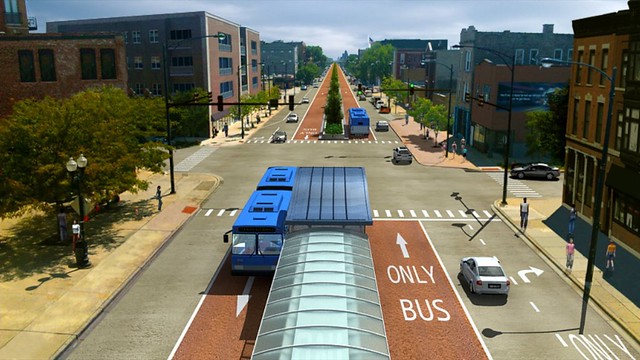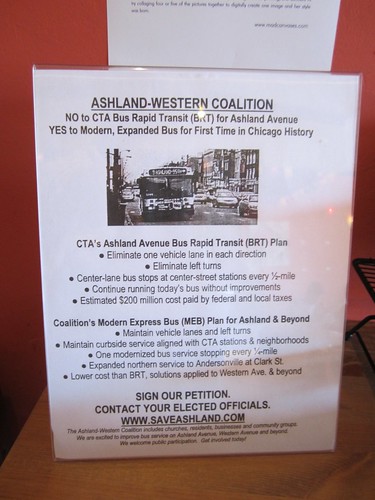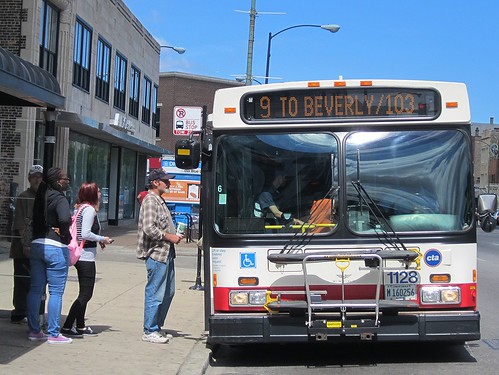The CTA has finally released the long-awaited environmental assessment of their plan to create fast, efficient bus rapid transit on Ashland Avenue, and federal officials say they expect “no significant impacts” from the project. However, a few items from the report are likely to provide fodder for the anti-BRT crowd. We’ll provide a full review of the 113-page document in the near future.
The transit agency had previously projected that average car speeds on Ashland, currently 18.3 mph, would be decreased by 4.9 percent to 17.4 mph by the conversion of two of the four travel lanes to dedicated bus lanes, and other changes. The EA states that vehicle speeds would be reduced by ten percent, to 16.47 mph.
The report also states that up to 12 percent of curbside parking spaces on Ashland would be removed, while the CTA had previously projected that only eight percent of spaces would be eliminated. However, the EA asserts that the overall effect on parking will be negligible, since much of Ashland has low parking demand, and parking is available on side streets, so no mitigation for the loss of parking is needed.
The study also found that 13 intersections in the project area, from 95th Street to Irving Park Road, would provide “unacceptable levels of service,” i.e. traffic flow, after BRT is implemented. However, the report also found that six of these intersections are already problematic, and it recommends treatments that would actually result in less delay at the 13 intersections than currently exists.
I assumed that Roger Romanelli’s anti-BRT group the Ashland-Western Coalition would seize on these three points at a public meeting they’d planned for this evening in Andersonville. A call to the venue revealed that the event was cancelled, since the AWC has opted to simply pass out their flyers, which feature misinformation about the CTA’s plan, in the neighborhood instead. But I expect we won’t have to wait long to read Romanelli’s take on the EA in the local dailies.
Suzi Wahl, a coalition ally who opposes BRT because she fears it will increase traffic on side streets, has already spoken out against the 30-day public comment period for the document. She told the Sun-Times she is “appalled” and “disgusted” that residents are given a month to read and comment on the report, noting that Thanksgiving and Hanukkah take place during this period.
While it would be nice if Chicagoans had more time to digest this weighty tome, 30 days is the standard review period for this kind of document – more than that would unduly delay the project. Personally, the idea of curling up by the fireside after a turkey dinner to peruse the report sounds very appealing, and the Festival of Lights is a relatively minor holiday, although my brother does stage an elaborate Hanukkah puppet show each year.
Furthermore, CTA spokeswoman Lambrini Lukidis told the Sun-Times that the document is just one step in the continuing process of planning the BRT system and does not necessarily reflect the final design. “There will be continued public feedback and dialogue as we move into the design phase,’’ she said.
While the EA's prediction of somewhat slower car speeds on Ashland than originally projected may seem to make it harder to convince Chicagoans that BRT is a good idea, it’s important to look at the big picture. The #9 Ashland bus has the highest ridership of all CTA bus routes with ten million boardings in 2012. If it were an 'L' line, it would be the seventh busiest out of nine, with higher ridership than the Pink or Yellow lines.
There’s currently an enormous inequality between the 18.3 mph average car speed of cars and the 8.7 mph buses. BRT will increase bus speeds by 83 percent, to 15.9 mph, so the relatively small, ten-percent reduction in driving speeds will lead to a big improvement in travel times for tens of thousands of Chicagoans each day. Roughly a quarter of the city's residents live within walking distance of the BRT route, and one in four of those households don’t own cars, so the much faster, more reliable transit service will have a positive impact on a huge number of people.
Members of the public can submit formal comments about the EA directly to the CTA or attend a public hearing to meet with CTA and Chicago Department of Transportation reps, who can provide additional info on the plans, and submit their views on the location, design, and social, economic, and environmental effects of the BRT proposal.
The community input meetings for the plan are scheduled for:
Tuesday, December 10
6 p.m. - 8 p.m.
Benito Juarez Community Academy
1450 West Cermak Road
Wednesday, December 11
6 p.m. - 8 p.m.
Pulaski Park Fieldhouse
1419 West Blackhawk Street
Written comments can be also submitted by emailing AshlandBRT@transitchicago.com or by mail to the Chicago Transit Authority, attn.: Joe Iacobucci at 567 West Lake Street, Chicago, IL 60661. To be included as a formal comment as part of the EA, comments must be submitted no later than 4:30 p.m. on December 20.








